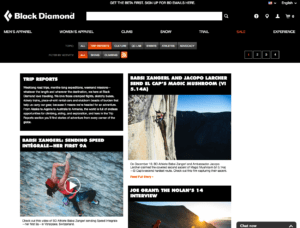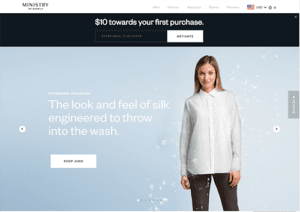Content is crucial to driving an online shopper who cannot handle or examine an item before purchasing it to click the Buy button. Good content not only shows off the benefits of the product, but convinces the shopper that buying from this particular site will get them the best experience.
The online retailers featured in this year’s Hot 100 content category put their products at the center of stories they tell—from how products are designed and tested to how they can improve a buyer’s daily life. And they do so in a variety of ways—from videos that showcase the product in action to in-depth interviews with experts.
Good content drives shoppers to buy
Video, in particular, is becoming an increasingly common way merchants such as like Black Diamond Equipment and Hodinkee build connections with fans and shoppers. For example, Black Diamond uses videos to show off products on sheer rock faces and snowy mountain tops, while Hodinkee’s lifestyle shows are centered on watches the company offers.
Other online retailers in the list pack the product pages themselves with helpful content. Skin care retailer Drunk Elephant gives precise details on what its products do and how to use them right on the product pages so buyers know if one will fit into their routines. Goodr’s sleek product pages use humor to convince shoppers why its sunglasses are better than the competition.
Showcasing how products can be used is another place where content shines. Lion Brand Yarn pulls in photos from Instagram that shows off what customers make with its yarns, needles and patterns. It also offers learning resources and patterns to customers at discounted prices, helping those buyers create more with the yarn-maker’s products. Tortuga Backpack’s blog offers articles like how to best pack its luggage for different kinds of packing lists, but also reviews of products the company doesn’t sell that a customer may pack in the retailer’s bags, like umbrellas, wallets and journals.
Ultimately, the content needs to sell the product. And shoppers want to know more before buying a food freeze dryer for thousands of dollars. HarvestRight’s homepage is full of details on what freeze drying can do for a customer’s cooking, and the product pages feature videos on how to use the product. A “Why Freeze Dry” section of the site dives deep into the advantages and has animated charts showcasing the benefits over other preservation methods.
Good content goes beyond the standard marketing spiel and makes consumers feel that the products are made for them, making brands stand out among endless online offerings.
Black Diamond Equipment takes its products and its sports seriously. Not only does the company manufacture outdoor gear aimed at mountaineers, backcountry skiers and hikers, it sells directly to consumers and through other retailers. Its website is brimming with information on its products, including sizing, material and country of origin for apparel and detail such as videos for sizing gloves.

But Black Diamond is also deeply involved in providing resources for climbers, skiers and hikers on the Black Diamond Experience section of BlackDiamondEquipment.com. The section provides inspirational stories, photos and videos from athletes, employees and partners. It also lists events and advocacy efforts designed to advance knowledge and support open lands and conservation. Community efforts include financial and technical support for climbing and skiing service organizations that have developed mobile apps for avalanche information centers in the Northwest.
The combined efforts are paying off. Black Diamond grew online sales by 63.7% in 2017, to $82.8 million, according to Internet Retailer estimates.
Radically engineered dress clothes retailer Ministry of Supply debuted its first product on Kickstarter in 2012 and raised more than $400,000. Following that success, it launched MinistryofSupply.com.
Built on the Shopify platform, the Ministry of Supply website features a wealth of details about the retailer and the products it sells. “They’re not only experiencing our brand online, but also learning detailed information about all of our products and the technology we use to create them,” says CEO Aman Advani.

“Selling clothing online comes with many challenges, as customers are unable to experience things like product fit and hand-feel, and over time, we’ve developed a formula for sharing this information and educating our customers,” he says.
To overcome these issues, the retailer uses video content, detailed product descriptions, including how the fabric feels and how the item will fit, and reviews from Ministry of Supply customers that address how the product performs and how it fits.
On its “technology” page, the retailer shows how each type of fabric has been developed and the function it serves in the overall garment, such as increased flexibility or stretchy fabric that doesn’t break down over time. When a shopper clicks on an image—for example, “Kinetic”—she is led to a product page featuring products with only that material, such as “women’s kinetic blazer” and “kinetic pencil skirt.”
Every article of clothing begins at the research process in which Ministry of Supply attempts to solve a consumer’s problem, for example, by pressure-mapping feet or interviewing people about how much they sweat. Products then undergo testing for durability and performance in the lab and in the real world with field testers. The retailer then takes the feedback and applies it to current and future clothing design decisions.
“People today are accustomed to performance clothing in the gym,” says Advani. “Merging the worlds of style and performance and tapping into their engineering expertise, Ministry of Supply applies the latest technologies and manufacturing processes to reinvent apparel so that it can flex with the demands of the modern professional.”
Ministry of Supply has also experimented with physical storefronts; it operates seven bricks-and-mortar locations, as well as the occasional pop-up shop. Even so, Advani says the brand is still primarily a digital-first company.
“We’ve found a great multiplier effect where customers get to know the brand through a physical experience, but can continue to build and grow a relationship with the brand online,” he says. “We’ve also found great ways to engage online, too—by prioritizing customer service, encouraging phone calls, and using social media to share more about what it looks like behind the scenes. We’re letting our customers get to know us.”
Sign in to see the rest of the omnichannel winners, or download the complete 2019 Hot 100 list from Internet Retailer.